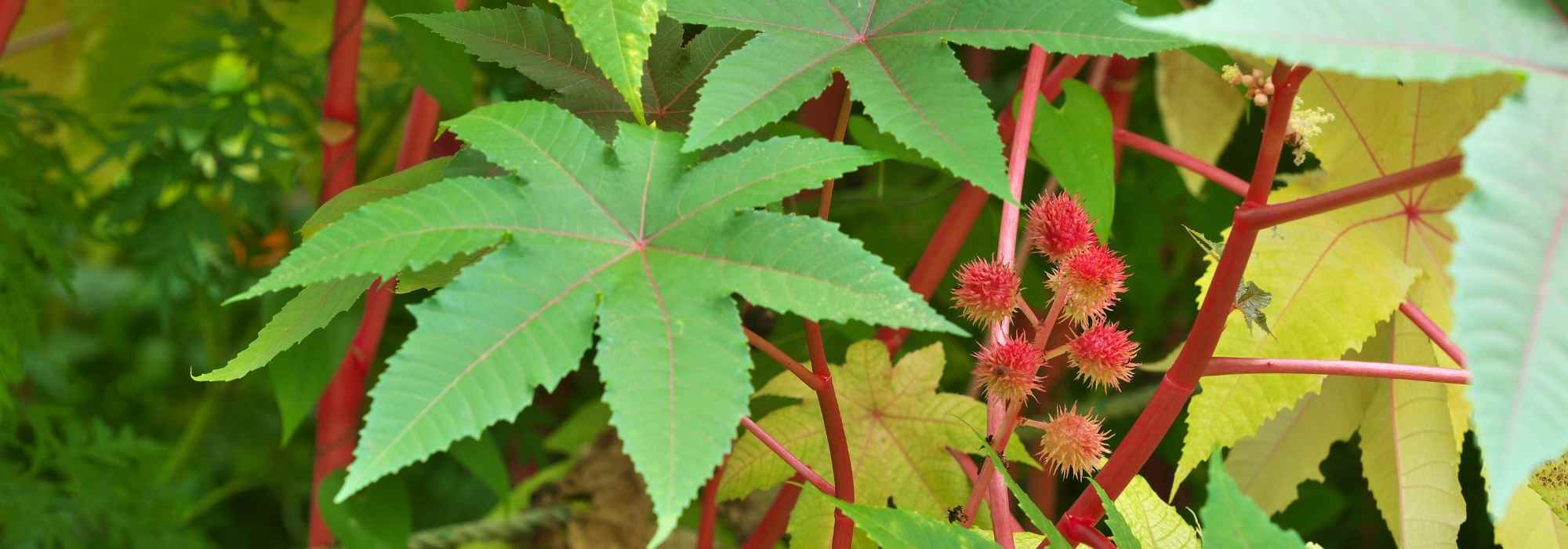
Castor oil plant: planting, sowing, cultivation
Contents
Castor oil plant in a nutshell
- It’s a stunning tropical plant that is grown as an annual
- Its green or purple palmate foliage will be the focal point for summer borders and containers
- It produces small, round, spiny fruits in late summer, scarlet or green, which are highly toxic but infinitely decorative
- It can reach 2 m in height within a few weeks, making it a reliable choice for the background of seasonal borders
- Easy to cultivate, it grows quickly in full sun in well-drained, rich soil
A word from our expert
With the Common Castor Bean, Ricinus communis, one can only admire the immense, strongly exotic palmate leaves! They attract all eyes with their beautiful lobed shapes that showcase fifty shades of purple, red, and green. Not to mention the fruit of the castor bean: small, bristly capsules in scarlet or pink, infinitely ornamental at the end of summer. But infinitely toxic as well! These fruits contain the castor seed: a true poison due to the ricin, a deadly toxin it contains. However, by cold pressing, one can extract from these seeds castor oil, also known as castor oil, a non-toxic oil that has multiple virtues and benefits.
The castor bean is a perennial herbaceous plant of tropical and subtropical climates that is quite frost-sensitive, typically grown in our gardens as an annual, either in the ground or in pots. The common castor bean comes in numerous varieties, all more desirable than the last, with superbly coloured foliage, more or less red.
While it forms a true tree in its native regions, in our climates it maintains modest dimensions. With very rapid growth, it can still reach nearly 2 m in height in the ground within a single season, as seen in the variety ‘Honolulu’.
This giant stands out as a focal point in an exotic setting, at the back of a flowerbed or on the terrace. By reading our article, you will discover how to cultivate it properly, learn which part of the castor bean is toxic, and what the benefits of castor seeds are.
Discover this spectacular and easy-to-grow perennial plant!
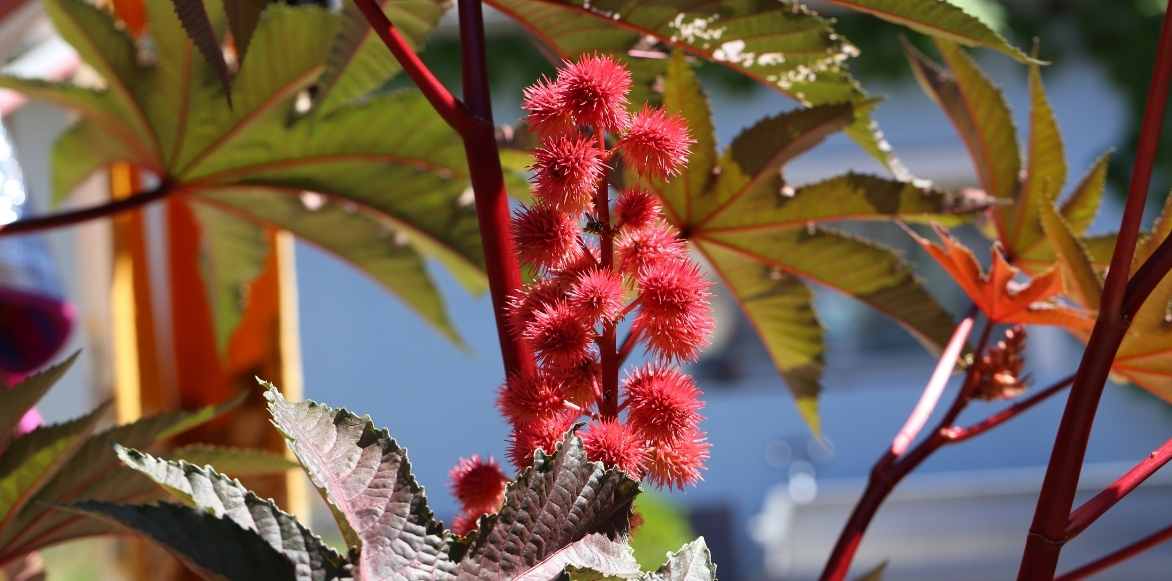
The extravagant and wildly exotic beauty of the castor bean
Description and Botany
“`html
Botanical data
- Latin name Ricinus communis
- Family Euphorbiaceae
- Common name Castor bean
- Flowering June to October
- Height 0.90 to 3 m
- Exposure Sun
- Soil type Rich, moist, well-drained
- Hardiness Frost-sensitive
The Common castor bean or Ricinus communis is a perennial herbaceous plant with a woody stump from the Euphorbiaceae family. Native to fallow lands and rocky slopes in North-East Africa and South-West Asia, it is a perennial of tropical and subtropical climates that is primarily grown as an annual in our temperate climates. Frost-sensitive, it dies at -3°C and may only survive in the ground in regions where it does not freeze. The genus Ricinus comprises only one species: Ricinus communis, which has about ten varieties, such as ‘Carmencita’ with dark red foliage or ‘Zanzibar’ with green fruits and very large leaves.
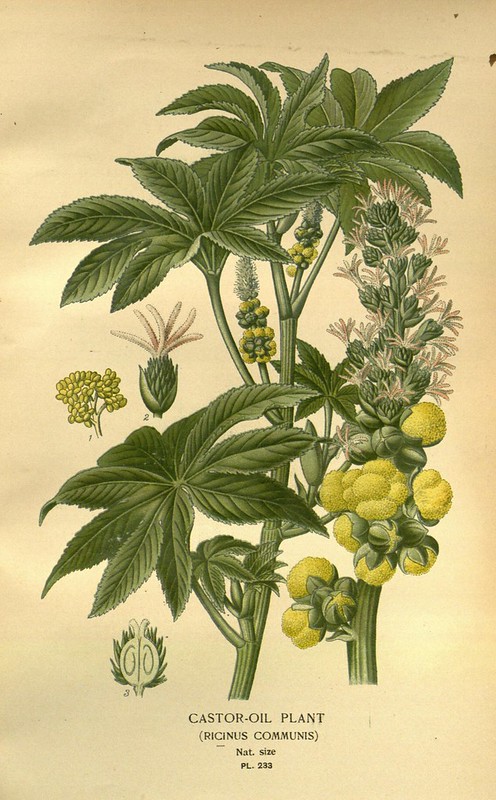
Ricinus communis: botanical illustration circa 1896
While in its native habitat it can form a bush nearly 10 metres tall, in our climates it maintains more modest dimensions. Fast-growing, this large perennial reaches between 0.90 and 2 m in the ground within a single season. It has a bushy, upright habit. The ‘Zanzibar’ variety is one of the tallest, capable of climbing to 3 to 4 m in regions where frost does not occur.
The castor bean is characterised by the beauty of its foliage. Its dark branches are spectacular! It develops large, palmately lobed green or purple leaves depending on the variety. Alternate, deeply palmatilobate (5 to 7 pointed lobes), and dentate, they can measure up to 20 cm in diameter, sometimes more. They resemble an open palm, the leaf of a plane tree, or that of a maple, revealing purple or white veins. These lush leaves are connected by long petioles to robust, knotted stems that are also coloured.
The foliage is sumptuous from spring to autumn. This ample foliage continuously changes colour, starting with red when juvenile, then bright green to purplish in the typical species. It takes on more or less purplish, wine-red, bright orange, or bronze hues depending on the cultivars, and appears green in ‘Zanzibar’. Lustrous, the foliage has a shiny texture.
The flowering is not particularly remarkable. Discreet, it occurs in summer, from July to October. Red and yellow in colour, the rather insignificant flowers are grouped in pyramidal racemes at the ends of the stems. Male flowers form yellowish tufts at the base, while female flowers are clustered at the top. However, the fruiting is quite decorative. The flowers are followed by clusters of ovoid fruits in capsules composed of three prominent shells, covered in soft thorns. They display a scarlet red or are sometimes pink in ‘Carmencita pink’, contrasting with the foliage.
At maturity, these fruits explode, releasing seeds that are projected several metres away. They will be dispersed by wind or birds, leading to spontaneous sowing. They are highly toxic if ingested.
The ricin contained in most of the plant is very toxic. The seeds, resembling blood-engorged ticks, contain a powerful alkaloid that was once used to create a deadly poison. Castor oil is extracted from it, a non-food oil, now used in the cosmetic, pharmaceutical, and even automotive industries. It is among the most widely used industrial vegetable oils in the world. It is notably included in cosmetic formulations. Once stripped of its toxic enzyme, it can be used for its benefits for skin and hair; it is reputed to promote eyelash growth!
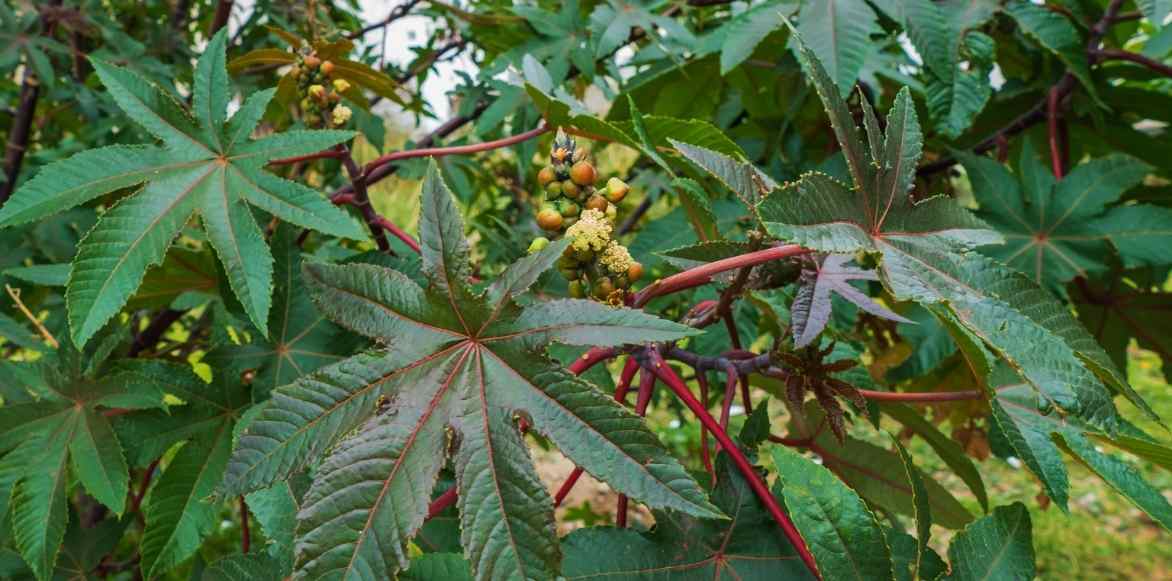
Foliage and seeds of the castor bean
“`
Read also
Annuals: seeds, plug plants or pots?Main varieties
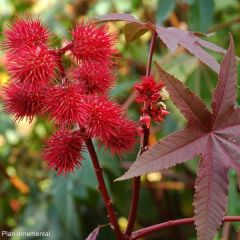
Ricinus communis Honolulu
- Flowering time September to November
- Height at maturity 2 m
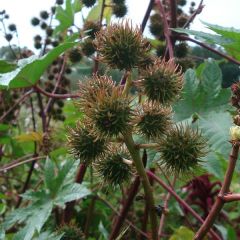
Ricin de Zanzibar
- Flowering time July to September
- Height at maturity 2 m
Discover other Ricinus - Common Castor Beans
View all →
Available in 1 sizes
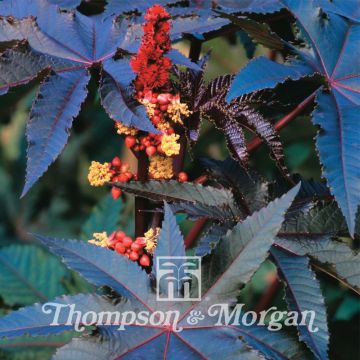
Available in 1 sizes
Available in 1 sizes
Available in 1 sizes
Available in 1 sizes
Available in 1 sizes
Castor bean planting
Where to Plant It?
Despite its robust appearance, castor bean is not hardy. This is why, in most of our gardens, it is grown as an annual plant, not surviving even the slightest frost. In the southern regions of our country, in the most sheltered areas, it can be grown as a perennial. The stump can be protected with a thick layer of leaves applied in autumn. Choose a sunny location, as it is a tropical plant that loves full sun and warmth. Reserve a spot sheltered from strong, cold winds that could cause its stems to bend. In windy conditions, it will need staking. Provide a good deep garden soil, rich in humus, well-drained, and remaining relatively cool throughout the growth period.
It will thrive in many sheltered gardens. It is interesting for creating a temporary decor in a very colourful summer exotic border. In the garden, common castor bean allows for quick filling of an empty area. Given its large stature, it will find its place in the sun, at the back of large perennial borders that are not exposed to draughts. It will add a beautiful exotic touch while highlighting neighbouring plants. It also stands out in large pots on the terrace to create a refreshing decor, allowing you to move it to the conservatory in winter for safekeeping.
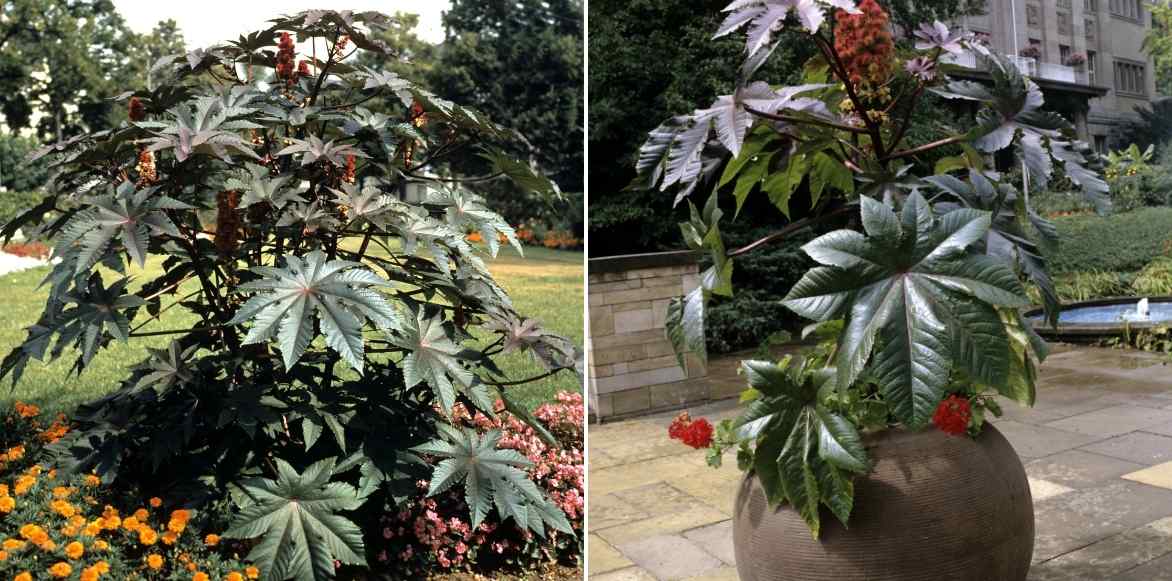
Castor bean planted in a flower bed and in a pot on a terrace.
When to Plant Castor Bean?
Planting of common castor bean takes place in spring, during May or June. Our plug plants will be installed outdoors as soon as the risk of frost has definitely passed.
How to Plant It?
In the Ground
Maintain a planting distance of about 1 metre between each plant. We suggest adding well-decomposed compost, as it appreciates soils rich in organic matter.
- Dig a hole 2 to 3 times wider than the plug
- In heavy soil, add clay balls or pumice at the bottom of the planting hole to improve drainage
- Add manure or decomposed compost if the soil is poor
- Plant in the planting hole
- Fill with a mixture of good potting soil, compost, and garden soil
- Place stakes if necessary and replace the soil, pressing down lightly
- Water generously
In a Pot
Plan to install it in a large pot with a drainage hole of at least 50 cm in diameter, as this large perennial has a significant wind resistance. Good drainage is essential.
- Spread a good layer of gravel or clay balls at the bottom of the container
- Plant in a mixture of good potting soil, compost, and garden soil
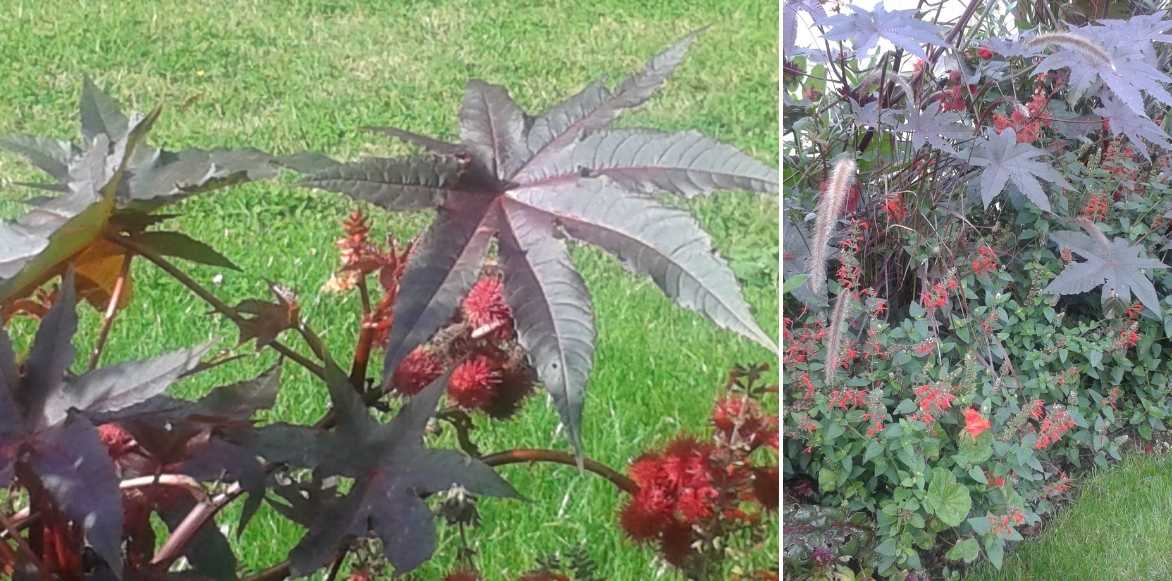
Castor bean planted in a predominantly red border (© Gwenaelle David)
Sowing castor seeds
Sowing castor bean seeds takes place in March or April in a warm sheltered environment. Soak the seeds in lukewarm water for 24 hours before sowing.
- Sow one seed per pot (or in a heated mini propagator) filled with good sowing compost and sand
- Cover the seeds with 1 cm of compost
- Lightly firm down
- Water generously with a fine spray and keep moist throughout germination
- Maintain a minimum temperature of 20°C
- Repot into larger pots when the young plants have sufficiently emerged
- Transplant into the garden when all risk of frost has passed
Castor oil plant care
In Open Ground
This annual requires no special maintenance. Water twice a week to keep the soil moist throughout the summer, especially during hot spells. However, avoid excess moisture. The soil can be kept cool with a mulch in summer. Stake if exposed to windy conditions.
Uproot the plants in autumn. If you live in a warm climate, you can leave the plant in place, but protect it from cold snaps with a thick mulch. Ensure you make annual additions of organic matter to maintain good humus content in the soil. Clean the clump at the end of winter by trimming the dry parts.
In Pots
Water generously in summer, never allowing the substrate to dry out between waterings. This plant is very hungry: apply fertiliser every 15 days to the watering water during the growth period.
As soon as the first frosts arrive, bring the plant indoors to protect it from frost in a conservatory or greenhouse where the temperature does not drop below 0°C. In winter, reduce watering, allowing the soil to dry out almost completely, and stop fertiliser applications.
Top up with potting soil and compost once a year in spring. Once the risk of frost has passed, you can take it back outside to enjoy the beautiful season.
Diseases and potential pests
Castor oil plant doesn’t really experience problems with diseases and pests. When grown indoors, it can occasionally be attacked by the red spider mites, which thrive in dry conditions. As a preventive measure, regularly mist the foliage.
When conditions are very humid and warm, it can be susceptible to Botrytis and powdery mildew, fungi that thrive in confined spaces with warm, humid air.
Multiplication
As we have seen, it is possible to sow castor seeds to multiply them (check our section a bit higher up titled “Sowing Castor Seeds”). You can harvest the seeds when they are ripe (the capsules turn brown and open), then store them in a paper bag for sowing in spring. But remember that toxic ricin is mainly found in the seeds, keep them well away from children.
What are the benefits of castor seeds?
Castor seeds are contained within bristly shells; they are toxic and deadly if ingested. Cold or hot pressing yields a non-food oil that is safe and has medicinal properties with numerous benefits. Castor oil is ancient, with its use dating back thousands of years, to 4000 BC! Highly nourishing and used externally, it is ideal for strengthening and nourishing hair, eyelashes, eyebrows, and nails. It also possesses emollient, hydrating, antimicrobial, and antifungal properties, these are very useful for the skin. In traditional Chinese medicine, castor oil is renowned for alleviating rheumatic and muscular pain. Rest assured, commercial oils are free from ricin!
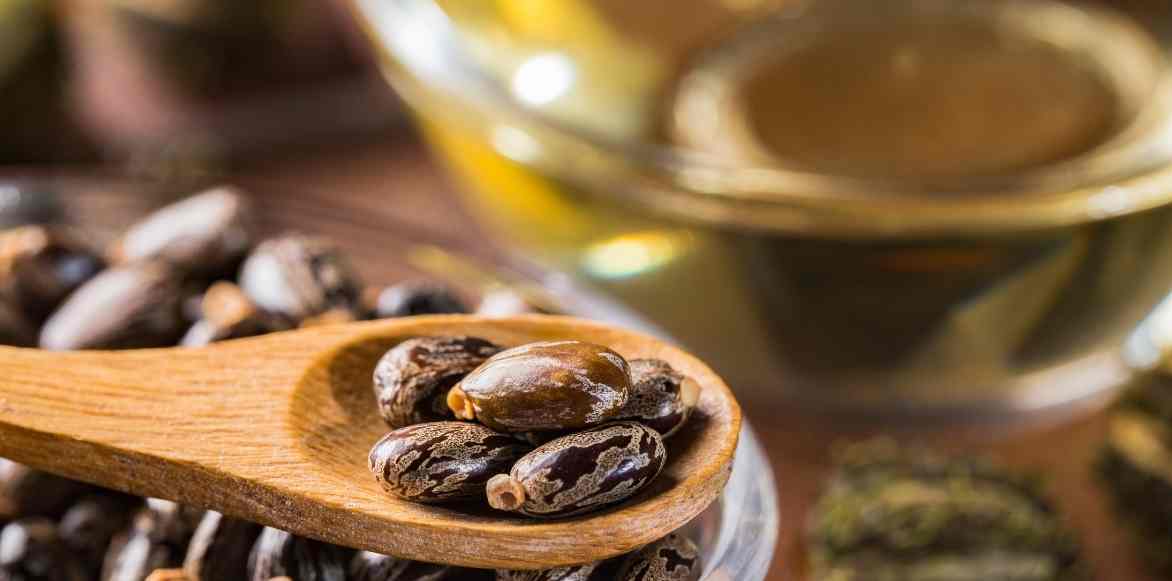
Seeds and castor oil
Associate
With its beautiful scarlet spiny fruits and ample, lush palmate foliage, Castor Oil Plant is perfect for filling out a tropical border in summer. Its large lobed leaves will blend perfectly into a tropical-themed setting. It allows for the creation of stunning ephemeral displays at the back of borders or in large pots on the terrace.
As a backdrop, create an exotic scene by pairing it with other plants featuring broad foliage, such as banana plants (Musa basjoo), a Chinese palm (Trachycarpus fortunei), and a Colocasia, another stunning tropical plant. To create harmony, add some bushes and perennials with dark foliage, such as Colocasia ‘Black Magic’, Albizia ‘Summer Chocolate’ in mild climates, Black Elder ‘Black Lace’, and Astilbe ‘Chocolate Shogun’. You will add floral touches in warm shades with crocosmias, some Cannas, kniphofias, gladioli, and daylilies; these plants will conceal its base, which tends to become bare easily.
You will also achieve beautiful contrasting combinations by pairing the purplish foliage of the castor oil plant with some tall blue agapanthus. In pots, you can surround it with shorter perennials like begonias and small annuals such as petunias, pansies, and some Coleus.
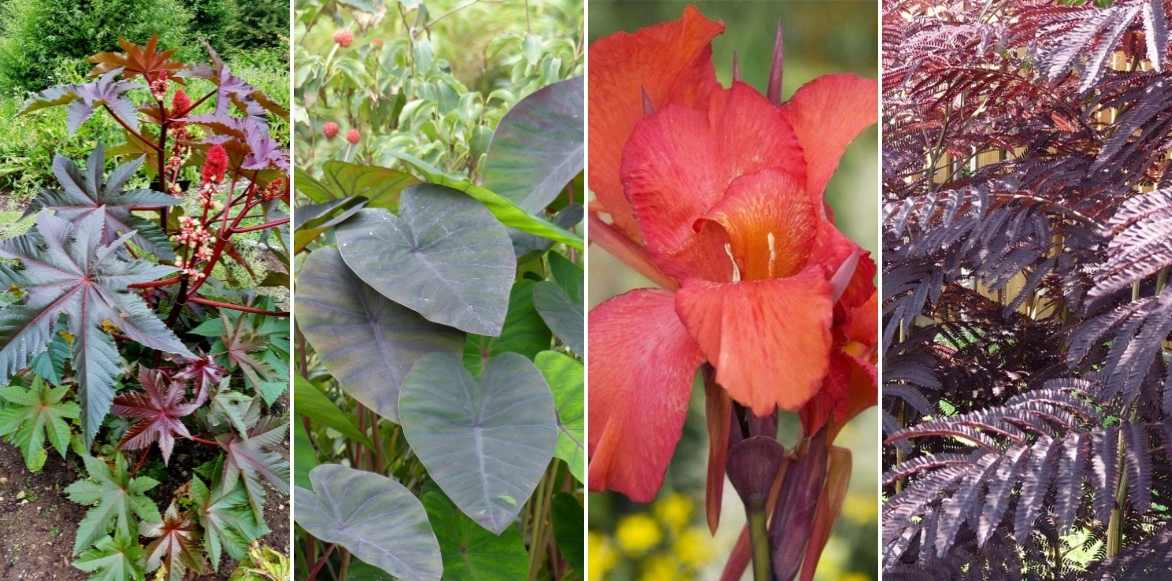
Ricinus communis, Colocasia ‘Black Magic’, Canna ‘Red King Humbert’, and Albizia julibrissin ‘Summer Chocolate’
Useful resources
- 10 exotic and hardy plants for Jungle garden
- For more ideas and inspiration – Exotic atmosphere
- Subscribe!
- Contents

































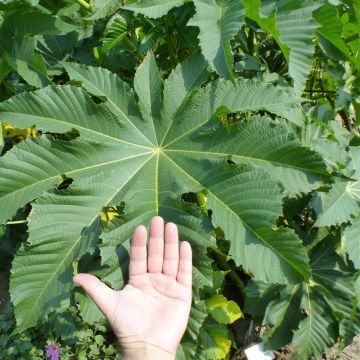

Comments